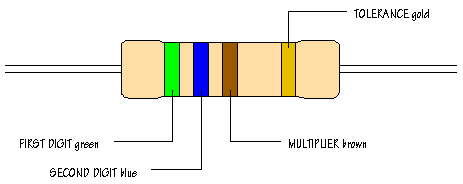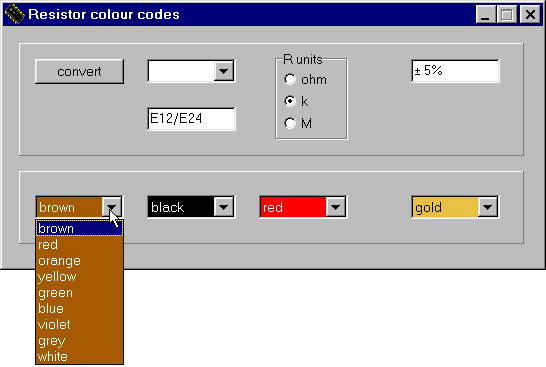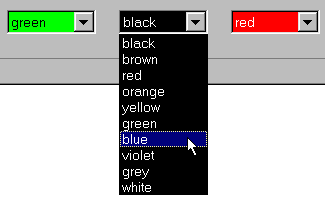The colour code convertor can be copied and distributed freely, but remains copyright
�. Distribution for profit seems unlikely, but is expressly forbidden.
How to use the program
1. Finding the resistor value corresponding to the colour code:
Hold your resistor with the tolerance band (usually gold) at the right hand end:

Within the colour convertor program, click on the FIRST DIGIT drop down arrow to see
the choice of colours:

Notice that black is not available as a
choice for the first digit colour.
Click on green. The focus moves
automatically to the drop down list for the SECOND DIGIT, where you select blue in exactly the same way:

The focus moves again, this time to the MULTIPLIER drop down list where you select brown. As soon as you click the brown, the focus moves to the convert button, and the resistor value, 560 ohm, appears
immediately in the result box.
When you select resistor colours in this way, the result appears automatically, without
clicking the convert button. However, if you
change only the first or second digit colour, without changing the multiplier colour, you
will need to click convert to initiate the
conversion process.
Note the effect of clicking on the ohm, k and M 'radio buttons'. The colour code for 560 k is given, but 560 M
is outside the normal range of resistor values and generates an error message.
2. Finding the colour code corresponding to a particular resistor value:
Suppose you want to find the colour code for a 390
ohm resistor. The program allows you to do this
in two ways. Clicking on the drop down arrow next to the result box gives a list of
E12/E24 values from which you can select by scrolling through:
 |
Once you have selected 390 from
the list, click on the ohm radio button: 
|
As soon as you click to select ohms, the
display changes to show the correct colour code, in this case:

As an alternative, you can enter a number directly in the result box. Numbers with two
significant digits are allowed, that is, 1.2, 12, 120,
but not 121 or 473. If you want to know the code for 1 200 ohms, enter 1.2 and click k.
Incorrect entries, or numbers which do not correspond to E12/E24 values generate
appropriate error messages.
3. Tolerance.
Tolerance refers to the percentage accuracy of the resistor value. Most resistors have
a gold coloured tolerance band, indicating an
accuracy of �5%, but other colours are possible and can be selected from the drop down
list.
4. E12/E24 values.
Resistors are manufactured in values which correspond to the E12 and E24 scales.
Details are given in the Resistors Chapter.
The program indicates whether a particular value is included in both scales, or is an E24
value only.
Click to Download Color Code Convertor Program
(File Name: colour_code.zip Size: 108 KB).